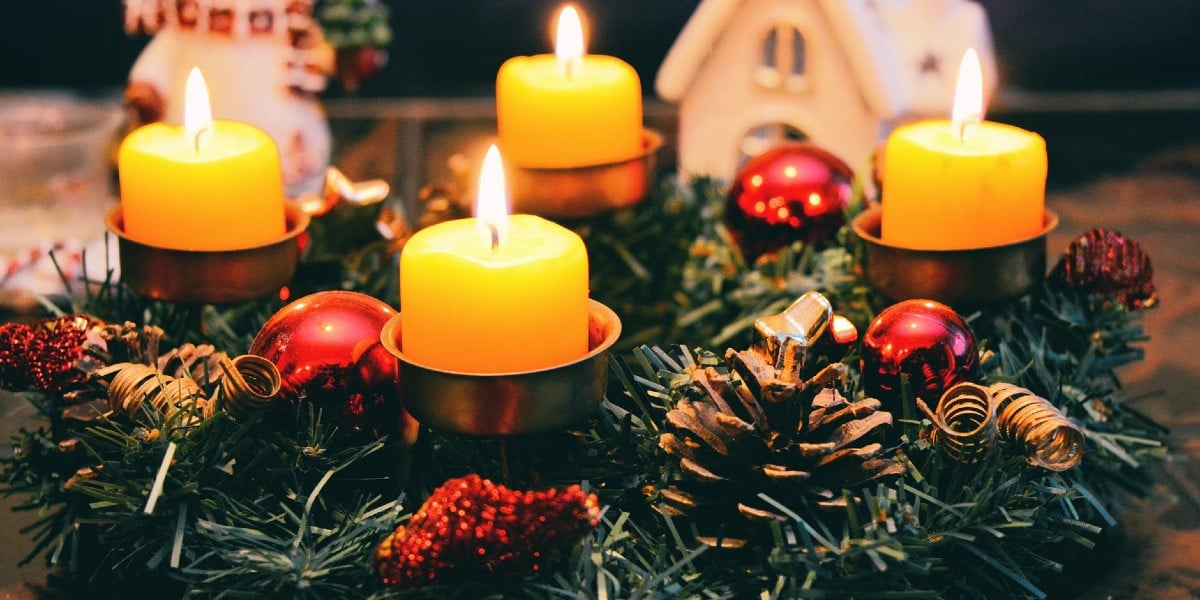Regina Caeli – Queen of Heaven, Rejoice!
The Regina Caeli, Latin for “Queen of Heaven,” is a hymn and prayer ...

This short rite of blessing is one of the sacramentals, official liturgical prayer, though it may be led by lay people. It is perfect for the blessing of the Advent wreathe in a home. This brief service is a wonderful way to begin a family’s observance of Advent on the First Sunday of Advent or whenever the family manages to get the family Advent wreathe set up! It may be done as part of grace either before or after the family meal. The Advent wreathe is a centuries-old European tradition: a wreath of fresh evergreens encircling four equidistant candles. Place it in the center of the dinner table or on a small table somewhere prominent in the house. Three violet candles represent the penitential aspect of Advent. One rose-colored or pink candle symbolizes the anticipated joy of Christ’s birth. One by one, each candle is lit on Saturday evenings during Advent until all four candles are burning in week four. In our home, we light the appropriate number of Advent candles each evening before the family meal as we sing a chorus of “O Come O Come Emmanuel” as part of our grace before meals.
All make the sign of the cross as the leader says:
Our help is in the name of the Lord.
All reply:
Who made heaven and earth.
One of those present reads the following Scripture text from Isaiah 9:1-2, 5-6
Brothers and sisters, listen to the words of the first letter of the prophet Isaiah:
The people who walked in darkness have seen a great light;
Upon those who dwelt in the land of gloom a light has shone.
You have brought them abundant joy and great rejoicing,
As they rejoice before you as at the harvest,
as men make merry when dividing spoils.
For a child is born to us, a son is given us;
upon his shoulder dominion rests.
They name him Wonder-Counselor, God-Hero,
Father-Forever, Prince of Peace.
His dominion is vast and forever peaceful,
From David’s throne, and over his kingdom,
which he confirms and sustains by judgement and justice,
both now and forever.
A priest or deacons then says the following prayer of blessing with hands outstretched; if the service is led by a lay minister, he or she says the prayer with hands joined and does not make the sign of the cross.
Lord God,
your Church joyfully awaits the coming of its Savior,
who enlightens our hearts and dispels the darkness of ignorance and sin.
Pour forth your blessings upon us as we light the candles of this wreath;
may their light reflect the splendor of Christ,
who is Lord, for ever and ever. Amen
FOR A FREE ADVENT & 12 DAYS OF CHRISTMAS “CHEAT SHEET” with many practical suggestions on how you and your family or study group can hope to make this the best Advent and Christmas Season ever, either sign up for free on our email list or confirm your existing subscription and then email us at [email protected] asking for your free copy. This document is not posted publicly on our website and is for our subscribers only.
This blessing of an Advent Wreathe is taken from The Book of Blessings, chapter 47.
For more great resources for the Advent Season, visit the Crossroads Initiative ADVENT RESOURCE LIBRARY
Banner/featured image of an Advent Wreathe by Pixabay on Pexels. Used with permission.
No Comments